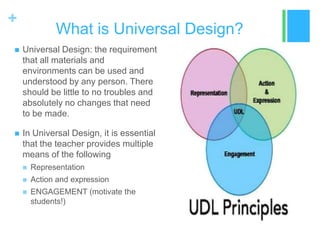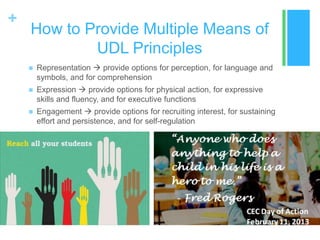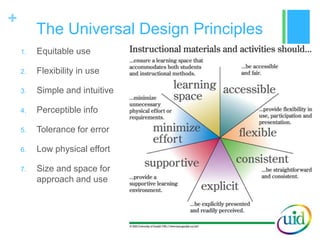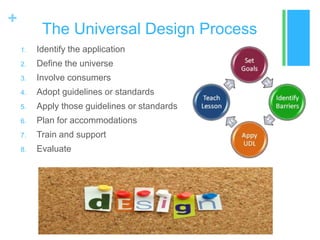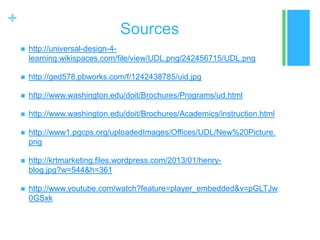Edp 279 Universal Design
- 1. + Universal Design in Education By: Alana Kenny
- 2. + What is Universal Design? ’ü« Universal Design: the requirement that all materials and environments can be used and understood by any person. There should be little to no troubles and absolutely no changes that need to be made. ’ü« In Universal Design, it is essential that the teacher provides multiple means of the following ’ü« Representation ’ü« Action and expression ’ü« ENGAGEMENT (motivate the students!)
- 3. + How to Provide Multiple Means of UDL Principles ’ü« Representation ’āĀ provide options for perception, for language and symbols, and for comprehension ’ü« Expression ’āĀ provide options for physical action, for expressive skills and fluency, and for executive functions ’ü« Engagement ’āĀ provide options for recruiting interest, for sustaining effort and persistence, and for self-regulation
- 4. + The Universal Design Principles 1. Equitable use 2. Flexibility in use 3. Simple and intuitive 4. Perceptible info 5. Tolerance for error 6. Low physical effort 7. Size and space for approach and use
- 5. + The Universal Design Process 1. Identify the application 2. Define the universe 3. Involve consumers 4. Adopt guidelines or standards 5. Apply those guidelines or standards 6. Plan for accommodations 7. Train and support 8. Evaluate
- 6. + The Importance of Universal Design ’ü« There are so many people struggling with disabilities and universal design makes their lives a little easier. Universal design is not just applicable in an education sense either ŌĆō it can be used in housing, organizations, and so much more. That is why it is so important that it is respected.
- 7. + Sources ’ü« http://universal-design-4- learning.wikispaces.com/file/view/UDL.png/242456715/UDL.png ’ü« http://ged578.pbworks.com/f/1242438785/uid.jpg ’ü« http://www.washington.edu/doit/Brochures/Programs/ud.html ’ü« http://www.washington.edu/doit/Brochures/Academics/instruction.html ’ü« http://www1.pgcps.org/uploadedImages/Offices/UDL/New%20Picture. png ’ü« http://krtmarketing.files.wordpress.com/2013/01/henry- blog.jpg?w=544&h=361 ’ü« http://www.youtube.com/watch?feature=player_embedded&v=pGLTJw 0GSxk
- 8. + SourcesŌĆ” ’ü« http://www.youtube.com/watch?v=vr3ardmq0a0&feature=relmfu ’ü« http://www.washington.edu/doit/Brochures/Academics/equal_access_hrl.html ’ü« http://www.washington.edu/doit/Brochures/Academics/equal_access_so.html ’ü« https://www.k-state.edu/humec/atid/UDF/images/UDPrinciples%20quote.gif ’ü« http://teacherweb.com/IN/MtHealtyElementary/StephanieCraig/REACHallofyour students.jpg ’ü« http://www.cec.sped.org/~/media/Images/Home/Primary%20Content/Images/2 013_0211_day_of_action_550x309.JPG ’ü« http://www.youtube.com/watch?v=rfsx3DGpv5o&feature=relmfu

